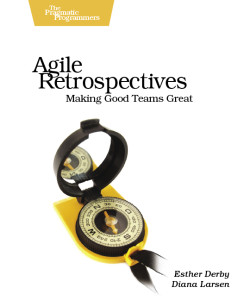Agile Retrospectives: Making Good Teams Great
 If you recall, this book by Diana Larsen and Esther Derby is the very first book in the required reading list for ScrumMasters from my Certified ScrumMaster workbook. This book is so fundamental to any successful Scrum Team (or any Agile team) that it is no surprise that Agile Retrospectives is the first book reviewed in The Way Forward.
If you recall, this book by Diana Larsen and Esther Derby is the very first book in the required reading list for ScrumMasters from my Certified ScrumMaster workbook. This book is so fundamental to any successful Scrum Team (or any Agile team) that it is no surprise that Agile Retrospectives is the first book reviewed in The Way Forward.
As you have heard me say, Retrospectives are the only piece of the Scrum framework that cannot be removed or modified. The Retrospective is the one piece of Scrum where you can rollback the changes you make to your process and restore the pieces you modified or edited out. While I do not recommend it, (especially for novices) you are permitted to revise, reshape, or even remove, any piece of the Scrum framework as long as you keep the end-of-Sprint Retrospective in place.
However, when a Retrospective is run inefficiently or without structure, it commonly loses its efficacy and becomes just another meeting the Team begins to dread. Since Scrum and Agile are all about continuous improvement, we need the Team to do their best thinking during this conversation buy youtube likes. To help that dialogue, we must offer the Team a compelling and engaging conversation that leads to specific Action Items.
What I really like about Ester’s and Diana’s book is that the offer a very clear framework on how to run a Retrospective, guidance on how to prepare for the Retrospective and techniques to keep your Retrospectives focused and fresh. This book is an easy read of less than 150 pages, so there is no excuse for not being able to finish this in a week.
The first three chapters describe their framework for running a Retrospective (see below), how to customize and prepare for a Retrospective followed by advice on how to lead a Retrospective. Chapters Two and Three provide clear details on how to create the agenda, how much time you need to reserve for each of the steps and good advice on what as the facilitator.
The list below identifies the five steps to running an effective Retrospective and you will recall the steps are sequential. You cannot jump from step #1 to #3 or #2 to #4 or drop out after step #4.
- Set the Stage: setting the stage helps people focus on the purpose of the Retrospective, reviews the goal of the conversation and creates the space where the participants feel comfortable discussing the topic at hand.
- Gather Data: at this point in the Retrospective we want to develop a shared understanding of what transpired during the last cycle. It is very important that everyone’s perspective is given an opportunity to be brought forth and considered by the entire Team.
- Generate Insights: now is the time to ask “Why?” and begin to examine alternatives. The goal of this phase is to see the big picture, understand root causes, consider new possibilities and look for connections between the data gathered moments ago. \
- Decide What to Do: as we draw near the end of our time in the Retrospective, the Team will need to select one or two action items that will make an improvement in the way they work together. No need to solve world peace here, just something that will make everyone’s day-to-day experience better.
- Close: provide a clear, crisp ending to the Retrospective and use this time to ask the Team how to make the next Retrospective better. Be sure to thank the Team for their efforts during the Retrospective and the Sprint that just ended.
The remaining chapters, four to eight, offer up specific activities you can try in each of the five steps listed above. In addition, Diana and Esther share their advice on how to facilitate each of the activities and give guidance on how much time each one takes. To me, the real value in this book are all the different ways you can run a Retrospective beyond the basic (and very dull) – “What worked well? What didn’t work well? What improvements should we make?”
So what are my favorites? I have to say if you need short and quick activities, Keep-Drop-Add or +’s\∆’s are great. You can never go wrong with simple post-it notes on the wall. If you have more than sixty minutes, or want to review multiple Sprints, Timeline works really well since it collects a LOT of raw data. Another popular technique from this book is Learning Matrix. Learning Matrix is great since you can highlight many different areas quickly and there is a free, on-line version for distributed Teams from Innovation Games. I often use Team Radar if I want to collect the same type of information from a Team over a long period of time to measure improvements.
Finally, if you want to see what Diana and Esther look like and sound like, they have an excellent 50-minute Google Tech Talk from January 25, 2007 that is really good. This is a good thing to watch when you are stuck on that conference call that won’t end.

